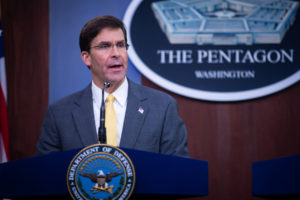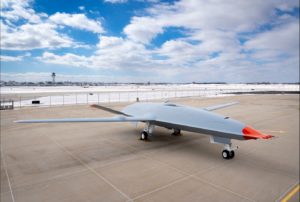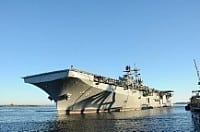Secretary of Defense Mark Esper said the new Navy future fleet plan calls for over 500 manned and unmanned ships by 2045, including more attack submarines, adding light aircraft carriers and fewer nuclear-powered carriers, and many unmanned vessels.
Speaking during an event at the Center for Strategic and Budgetary Assessments on Tuesday, Esper called this plan Battle Force 2045.

“Battle Force 2045 calls for a more balanced Navy of over 500 manned and unmanned ships. Further, we will reach 355 traditional battle force ships prior to 2035, the time at which the [People’s Republic of China] aims to fully modernize its military. And most importantly, we now have a credible path for reaching 355-plus ships in an era of fiscal constraint.”
Earlier this year, Esper directed Deputy Secretary of Defense David Norquist to conduct a study on the Navy future force plans to better integrate them with the overall defense posture and modify the Navy’s force structure assessment (Defense Daily, Sept. 11).
Esper said the proposal first calls for a larger submarine force of 70 to 80 attack submarines, starting with building more Virginia-class vessels as soon as possible.
“If we do nothing else, the Navy must begin building 3 Virginia-class submarines a year as soon as possible. Additionally, we intend to refuel the 7th Los Angeles-class (SSN-688) submarine and continue investing in the future attack submarine, SSN(X).
This is an increase over previous Navy plans to extend the life of up to five of the vessels. In 2018, Navy officials told a congressional panel they planned to extend the life of one Los Angeles-class attack submarine by 10 years before seeing if they will repeat the process on up to four more for five total (Defense Daily, March 22, 2018).
Second, the mix of traditional nuclear-powered aircraft carriers and light carriers would change, reducing the current goal of 12 carriers.
Esper said while nuclear-powered aircraft carriers “will remain our most visible deterrent, with the ability to project power and execute sea control missions across the globe,” light carriers will supplement them to “provide additional presence and capacity to carry out day-to-day missions and free up super carriers for more critical high-end fights.”
Although Esper said he anticipates further study to assess the proper high-low carrier mix, the department is initially thinking eight to 11 super carriers and up to six light carriers.
“We continue to examine options for light carriers that support short take off or vertical landing aircraft. One model we’re considering is the [amphibious assault ship] USS America [LHA-6] as it’s equipped with more than a dozen F-35Bs,” Esper said.
The third change plans for the future force to comprise 140 to 240 unmanned and optionally manned surface and underwater vessels. Esper said they could perform a “wide range of missions” including resupply, surveillance, minelaying, missile strikes, and decoys to help with the Distributed Maritime Operations plan for Navy operations.
“Moreover, they will add significant offensive and defensive capabilities to the fleet added in affordable cost in terms of both sailors and dollars.
Esper noted earlier this month the first Sea Hunter unmanned surface vessel prototype completed operations with the USS Russel (DDG-59), “demonstrating that unmanned surface vehicles are technologically feasible and operationally valuable.”
Fourth, the future fleet is planned to include a larger number of smaller surface combatants, 60 to 70.
Esper argued these vessels “will not only increase capacity to conduct distributed maritime operations, but it will also free other critical assets for more efficient mission distribution.”
He highlighted the guided-missile frigate, FFG(X) program as a “preview of where we are headed.”
Fifth, Esper said “sufficient strategic lift and logistics vessels are key to the sustainability of distributed operations,” with initial estimates identifying 70 to 90 combat logistics ships required.
However. Esper said further work is still underway to determine if the numbers forecasted in the report are sufficient and to ensure ground combat forces can get to the fight by sea on time.
Sixth, Esper said the Navy “must develop and deploy” carrier-based unmanned aircraft of all kinds: fighters, refuelers, early warning and electronic attack. Although this was not analyzed in detail in the study, he said the department will continue to assess the proper mix needed.

The final provision is that Esper said he supports integrating the Marine Corps’ new Force Design 2030 effort and the new classes of ships needed for it. Therefore, “we see a need for more amphibious warfare ships than previously planned,” in the 50 to 60 range.
Esper admitted achieving this new plan will not be easy, but Battle Force 2045 plans to work within “real world budget constraints” and said the Navy must continue its efforts at reforms to free up additional funds to shift to shipbuilding.
Esper was alluding to a new Stem-to-Stern strategic review former Acting Secretary of the Navy Thomas Modly said he directed in February, aimed at saving $8 billion per year to reach $40 billion in savings over five years (Defense Daily, Feb. 19).
“The Navy must continue these initiatives, they are essential to ensuring an adequate shipbuilding account to the task ahead,” Esper said.
Esper said given “serious reform efforts” put forward by the Secretary of the Navy and Chief of Naval Operations, he agreed to provide additional funding from across the DoD enterprise. This is harvested from reform efforts including combatant command reviews, 4th estate reforms, and other initiatives.
“Together, these additional funding streams will increase the shipbuilding account to 13 percent within the Navy’s topline – matching the average percentage spent to produce ships from President Reagan’s buildup in the 1980s.”
Last month, in prepared remarks for a speech he did not speak at the time, Esper previewed the plan would increase the Navy’s shipbuilding budget to 13 percent of its topline, compared to the current 11 percent (Defense Daily, Sept. 16).
Esper also asked Congress for additional assistance to reach the Battle Force 2045 goals. He said DoD needs sustained, predictable and timely budgets “which means no more continuing resolutions” as well as authorities allowing the Navy to divest from legacy systems and lower priority activities and redirect them to higher priorities and statutory authority for unused end of year Navy funding to be directed into the shipbuilding account instead of letting it expire.
Esper noted this new plan comes after he had Norquist examined three options for the future force, modeled and wargamed the options, and analyzed each combination of ship sets. The plans are partially based on competing with China’s plans for its future modernized naval forces.
